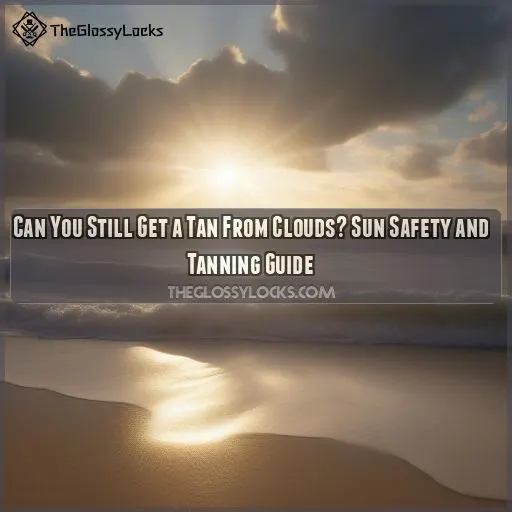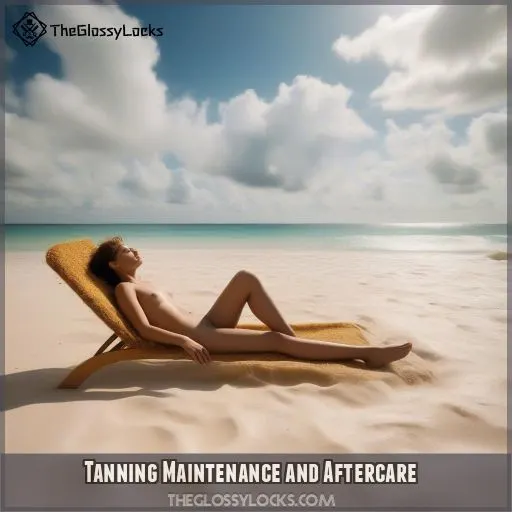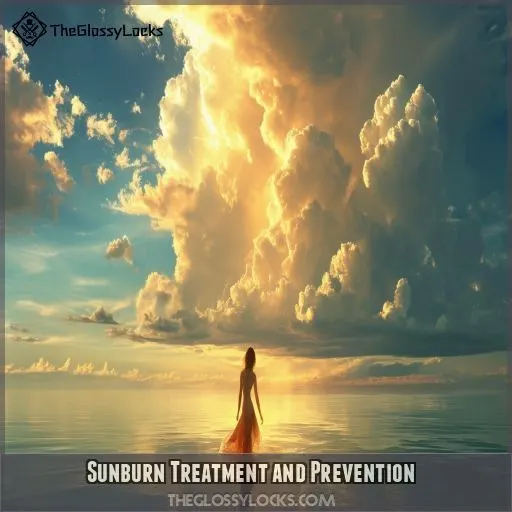This site is supported by our readers. We may earn a commission, at no cost to you, if you purchase through links.

Amazingly, yes. Up to 90% of UV radiation passes through clouds, which may give your skin the ability to tan or burn.
To keep your skin safe, it is essential to understand the science of UV radiation and how to defend the skin from its dangers.
This guide will help explain how UV rays work concerning tanning, why one must protect the skin even on a cloudy day, and good maintenance and aftercare techniques for tanned skin
Table Of Contents
- Key Takeaways
- Can You Still Get a Tan From Clouds?
- The Science Behind Tanning
- Tanning Through Clouds
- Sun Protection on Cloudy Days
- Tanning Maintenance and Aftercare
- Sunburn Treatment and Prevention
- Frequently Asked Questions (FAQs)
- Can I still get a tan if it’s cloudy?
- Is it okay to look at the sun through clouds?
- Can you still tan in the shade?
- Can I tan if it’s windy?
- Can You Tan in cloudy weather?
- Why do we get a tan on cloudy days?
- How to get a Good Tan on a cloudy day?
- Can you get a cloud Tan longer than a clear day?
- Can you tan through clothes or swimwear?
- How long does a cloudy day tan last?
- Do certain medications affect tanning on cloudy days?
- Can you get vitamin D from tanning through clouds?
- Does altitude impact tanning potential on overcast days?
- Conclusion
Key Takeaways
- Clouds are nature’s tricksters when it comes to tanning – they let up to 90% of UV rays sneak through, meaning you can still get that sun-kissed glow (or lobster-red burn) even on overcast days. Talk about a sneak attack on your skin!
- Don’t let cloudy skies lull you into a false sense of security. Just because you can’t feel the sun’s warmth doesn’t mean it’s not working its magic (or mischief) on your skin. Always slap on that sunscreen, rain or shine!
- Tanning through clouds is like trying to cook a steak on low heat – it takes longer, but you’ll still end up well-done if you’re not careful. Keep an eye on the clock and don’t overstay your welcome in the great outdoors.
- Your skin is like a good leather jacket – it needs proper care to stay supple and gorgeous. After your cloud-tanning session, treat it to some TLC with cooling showers, moisturizer, and maybe even a little aloe vera if things got too toasty. Your future self will thank you!
Can You Still Get a Tan From Clouds?
Yes, you can still get a tan from clouds. Don’t let overcast skies fool you – up to 90% of UV radiation penetrates most cloud types. This means your skin is still at risk for tanning and damage, even when it’s cloudy.
UVA rays, which cause tanning and aging, are particularly sneaky and can pass through clouds easily. You might not feel the heat, but your skin is still absorbing those rays.
Always use sunscreen with at least SPF 30, seek shade during peak hours, and stay hydrated. Remember, a tan is your skin’s way of trying to protect itself from harm.
Let’s explore how to stay sun-safe in all weather conditions
The Science Behind Tanning
Tanning occurs due to the interaction of your skin with ultraviolet (UV) radiation, primarily from the sun. UV radiation triggers skin changes, including increased melanin production, which leads to a darker skin tone
Types of UV Radiation
UV radiation, essential for tanning, comes in three types: UVA, UVB, and UVC. Understanding these can help prevent skin damage.
- UVA rays: Penetrate deep into the skin, playing a primary role in skin aging and tanning. Though they’re less intense than UVB, they’re more prevalent.
- UVB rays: Cause skin reddening and sunburn. They damage the skin’s outer layers and are potent in creating a tan.
- UVC rays: Thankfully, these are absorbed by the Earth’s ozone layer and don’t reach the ground.
Keep these in mind while tanning, especially under clouds
Skin Changes
When you tan, UV rays make your skin cells produce more melanin—and you turn bronze. But that’s just a symptom of skin damage.
Too much UV from the sun or reflection can lead to sunburn, premature aging, and even skin cancer. Similar risks are associated with tanning beds; even clouds filter only 10 percent of sunlight, and all that gets through in the form of UV rays.
That’s why it’s so important to take care of yourself in the sun—even when it’s cloudy. Always wear sunscreen, seek shade, and be sun-aware.
Every tan is your skin screaming for help
Tanning Through Clouds
Even on cloudy days, UV rays penetrate the clouds and can cause tanning. This can make tanning on cloudy days dangerous due to the increased risk of unintentional sunburn
Penetration of UV Rays Through Clouds
You might think you’re safe under cloudy skies, but UV penetration through clouds is real. About 90% of UV radiation can pierce through most cloud types. This means your skin isn’t entirely shielded, and you remain at risk for sunburn and skin damage.
To stay protected, always use sunscreen with SPF 30 or higher, regardless of cloud coverage. Clouds create a false sense of security, and neglecting sun protection can lead to severe outcomes. Prioritize applying sun cream to safeguard against the lurking UV rays even when the sun isn’t visible
Risks of Tanning on Cloudy Days
Tanning on cloudy days isn’t without risks. The sun’s rays penetrate the clouds, leading to UV exposure that can cause sunburn. Here’s why you should be cautious:
- False Security: Clouds give a misleading sense of safety, encouraging longer sun exposure.
- UV Penetration: Up to 90% of UV rays can pass through clouds, still damaging your skin.
- Increased Exposure: Reflective surfaces like water amplify UV impact.
- Sunburn Risks: Expect severe sunburn due to a lack of perceived heat.
Always use sunscreen, even on cloudy days, to protect your skin
Sun Protection on Cloudy Days
Even on cloudy days, wearing sunscreen is vital because UV rays can penetrate clouds and harm your skin. To ensure you’re protected, remember to use a high SPF sunscreen, seek shade during peak hours, and stay hydrated
Importance of Sunscreen
You may think that clouds will safeguard you from UV radiation; however, they don’t stop UV radiation. It means applying sunscreen is paramount, even on overcast days.
If your sunscreen has high SPF ratings of 30 or more, it will likely contain adequate UVA protection. Slather enough onto all exposed skin and reapply every two hours if you’re going to sweat or spend time in the water.
Proper sunscreen application not only helps prevent sunburns but also reduces your risk of skin cancer. So, keep your skin safe, regardless of the weather!
Sun Safety Tips
Sun protection measures remain essential even on cloudy days. Clouds can give a false sense of security, but UV rays still penetrate, posing risks. You should take proactive steps to prevent sunburn:
- Wear protective clothing like hats and sunglasses.
- Hydrate continuously to support your skin.
- Seek shade during peak UV hours (10am-4pm).
- Apply and reapply sunscreen with SPF 30 or higher every two hours.
- Avoid tanning beds as they emit harmful UV rays.
Ensuring proper precautions can help maintain your skin’s health and avoid the dangers of sunburn
Tanning Maintenance and Aftercare
Exfoliate your skin to remove dead cells so the tan spreads evenly. Moisturize regularly to keep the skin hydrated, and take cool showers to avoid stripping off the natural oils of your skin.
Exfoliation and Moisturization
Exfoliate your skin before tanning to remove dead cells so the tan can develop evenly. Use gentle scrubs 1-2 times weekly for best results, or use chemical exfoliants. This will put your skin in the best position to absorb tanning lotions.
| Benefits of Exfoliation | Exfoliation Frequency |
|---|
Removes dead skin cells. 1-2 times per week.
Apply a moisturizing lotion with ingredients like aloe vera, glycerin, and even vitamin E to the skin right after tanning, then daily after. Massage in gently into damp skin for best results. This will help you continue to glow and not peel.
Shower Temperature and Illuminating Lotions
After tanning, opt for a cool shower to soothe your skin. Keep your shower length short, around 5-10 minutes, to avoid drying out your skin.
Use gentle shower gels, avoiding those with harsh chemicals. Reduce your shower frequency, ideally to once daily, and keep shower pressure moderate to prevent stripping your skin’s natural oils.
An illuminating lotion post-shower can enhance your tan, giving it a radiant glow. Lightly pat your skin dry with a towel, and avoid vigorous rubbing which can irritate your newly tanned skin
Sunburn Treatment and Prevention
To treat sunburn, cool your skin with a cold towel or shower and stay hydrated by drinking plenty of water. For prevention, wear sunscreen, limit sun exposure, and avoid tanning during peak hours
Cooling the Skin
Cooling of the skin is necessary after tanning. It involves using a cool towel or a cool shower to try to reduce inflammation.
Sunburn cooling techniques minimize redness and pain.
After tanning, moisturizing is essential. Application of aloe vera gel is necessary for rehydration and the healing process of the injury.
Avoid hot showers to keep the skin calm and hydrated
Hydration and Pain Relief
Treatment for sunburn is significantly related to hydration. It will help in maintaining the balance of electrolytes and heal your skin.
You should drink ample amounts of water throughout the day to stay well-hydrated.
For pain relief, NSAIDs work excellently, such as ibuprofen or aspirin. These drugs will help in fighting inflammation and reducing pain.
Keep in mind to drink enough fluids since sunburning quickly dehydrates you
Avoiding Further Sun Exposure
To prevent further skin damage, follow these steps after sunburn:
- Wear protective clothing: Choose long sleeves and wide-brimmed hats.
- Seek shade: Avoid direct sunlight, especially during peak hours.
- Monitor for long-term effects: Sunburns can increase sun sensitivity and lead to increased skin damage over time.
Take care of your skin to minimize long-term harm
Frequently Asked Questions (FAQs)
Can I still get a tan if it’s cloudy?
Yes, you can still get a tan on cloudy days. UV rays penetrate clouds, so your skin’s exposed to tanning radiation. Don’t be fooled by overcast skies – you’ll need sunscreen to protect yourself from potential sunburn
Is it okay to look at the sun through clouds?
No, it’s not okay to look at the sun through clouds. You’ll still damage your eyes. Clouds don’t block harmful rays. Always protect your vision and never stare directly at the sun, cloudy or not
Can you still tan in the shade?
You can tan in the shade, but it’s not as effective as direct sunlight. While UVB rays are blocked, UVA rays still penetrate, causing slower tanning. For safety, always use sunscreen and limit exposure time
Can I tan if it’s windy?
Yes, you can tan when it’s windy. Wind doesn’t block UV rays, so your skin’s still exposed. However, the cooling effect might make you less aware of sun exposure. Always use sunscreen and limit your time outside
Can You Tan in cloudy weather?
Yes, you can tan in cloudy weather. UV rays penetrate clouds, allowing your skin to produce melanin. However, it’s slower and less intense than direct sunlight. Don’t forget sunscreen – clouds don’t block harmful rays entirely
Why do we get a tan on cloudy days?
You tan on cloudy days because UV rays penetrate clouds, reaching your skin. They stimulate melanin production, causing your skin to darken. You’re often less cautious, spending more time outdoors, which increases UV exposure and tanning potential
How to get a Good Tan on a cloudy day?
You can still tan on cloudy days. Apply a broad-spectrum sunscreen, find an open area, and spend 15-20 minutes outside. Don’t overdo it – UV rays penetrate clouds, so you’ll tan gradually. Stay hydrated and reapply sunscreen regularly
Can you get a cloud Tan longer than a clear day?
You can potentially tan longer on a cloudy day, as you’re less likely to notice sunburn. However, it’s not safer. UV rays still penetrate clouds, so you’ll need sunscreen and careful monitoring to avoid damage
Can you tan through clothes or swimwear?
You might think your clothes shield you completely, but they don’t. UV rays can penetrate fabric, especially when it’s wet or thin. You can tan through clothes, but the protection varies. Darker, tighter-woven fabrics offer more defense
How long does a cloudy day tan last?
A cloudy day tan typically lasts 3-5 days, depending on your skin type and aftercare. You’ll want to moisturize daily to maintain it. Remember, cloud tanning isn’t as effective as direct sunlight, so results may vary
Do certain medications affect tanning on cloudy days?
Yes, certain medications can affect tanning, even on cloudy days. Some antibiotics, antidepressants, and acne treatments may increase your skin’s sensitivity to UV rays. Always check with your doctor and take extra precautions when tanning while on medication
Can you get vitamin D from tanning through clouds?
While some amount of vitamin D can still be obtained through clouds, it’s minimal. The majority of UVB rays, which produce vitamin D, are blocked. You’ll have to expose yourself to direct sunlight on sunny days for sufficient synthesis of vitamin D.
Does altitude impact tanning potential on overcast days?
Like a mountain reaching for the sun, altitude amplifies your tanning potential. On overcast days, you’re closer to UV rays, increasing exposure. Your skin’s still at risk, so don’t forget sunscreen. Higher elevations mean more intense UV radiation
Conclusion
Like a wolf in sheep’s clothing, clouds can deceive you about UV exposure. Remember, you can still get a tan from clouds, as they allow most UV rays to pass through.
Protect your skin daily, regardless of the weather. Use sunscreen, seek shade, and wear protective clothing.
If you do tan, maintain your skin’s health with proper aftercare.
Stay vigilant about sun safety, and you’ll keep your skin healthy while enjoying the outdoors. Always prioritize protection over the pursuit of a tan








